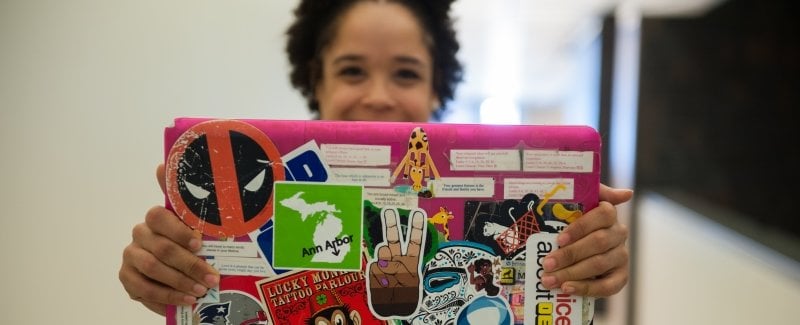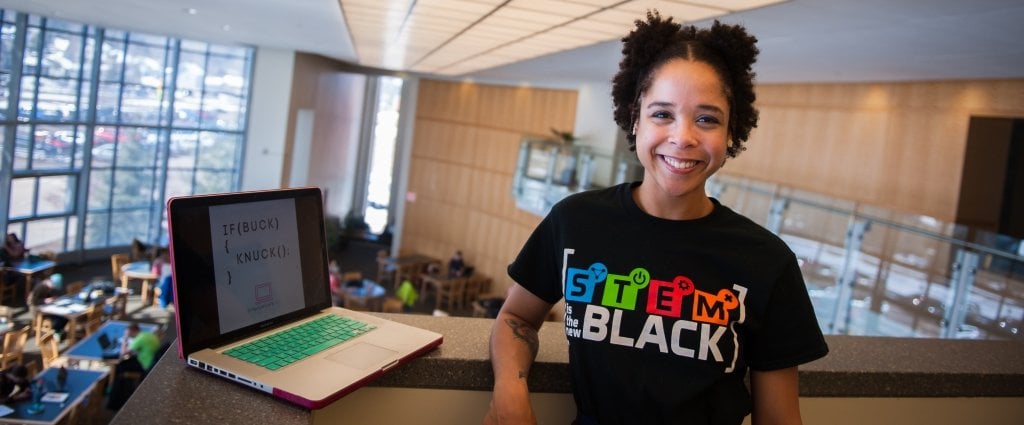The student who aims to be the first black Computer Science PhD graduate in Michigan Tech history codes rap songs and crusades for technological diversity on Instagram. Fellow tech geeks can follow her tips to build a social media presence.
Nine months and 106 posts in, Jamie Berger has 2,423 followers, and counting. As anyone who's tried to establish a social media following can attest, those are impressive numbers for a non-celebrity. But Berger's burgeoning success isn't defined by likes, shares and follows. She's tapping into the potential of social media for the greater good: to communicate computer science and STEM education in the context of diversity and black female empowerment; to lay out a path for underrepresented minorities in computing.
The Ann Arbor, Michigan native began her undergrad studies in South Florida, but quickly discovered a hot climate doesn't suit her. She returned North to earn her mathematics degree from Eastern Michigan University. She didn't come to Michigan Tech seeking even colder weather. "I came here because I didn't have any friends who were involved in technology or understood it at my level," she says, laughing. "I wanted to be with Tech-y people."
Berger's research topic, centered on Native Americans and computing, sprang from her surroundings. "I love figuring out how people learn and how to make learning better. I got really lucky with my research because it's related to what's around me. We have a large Native American population. Why don't we have more pipelines to Michigan Tech? A nice green flag, something to do here. "
"It inspires my work more to use my life experiences to form my research question."
The University awarded the first BS in computer science in 1974. The PhD program has been offered since the early 2000s. Berger, who hopes to graduate in 2021, wasn't expecting to be the first black person to earn a computer science doctorate at Michigan Tech.
"It's exciting and surprising at the same time," she says. At first, she thought the gap might have something to do with diversity in the region. But as she began to attend conferences, she learned otherwise. "This is very common at a lot of schools. It's a way bigger issue than at Michigan Tech."
So she looked for the most effective way to take a big issue to a bigger audience. The answer: social media.

Social Media Tip: Pick one platform and do it well
There are many social media platforms to choose from. It can be overwhelming, especially if social media isn't already a part of your life. Berger experimented with other platforms both before and after she landed on Instagram.
"I don't have Twitter, or Facebook, or anything like that," she says. "For a while I didn't have any social media at all." Berger finally felt like she couldn't avoid Facebook because it's the only place she could get info on student orgs she's involved in.
"Then I noticed that a lot of things that come up on Facebook are just really negative. Everybody complaining about their lives. Why am I spending even a minute of my day looking at this right now? My boyfriend was on his Instagram all the time. I was like, 'dude, get off your phone, I don't get it, it's just pictures.'" But she was intrigued when he mentioned the sense of community and the connections he'd made on the platform.
"I deactivated my Facebook and went on Instagram," Berger says. "Then I found Sage Franch, the Trendy Techie. She was the first female and computing Instagram page I came across—at the time she was working at Microsoft in Toronto. Now she's developing her own startup in blockchain technology. I started seeing more and more female coder pages. There's a bunch. I've gotten in touch with people all over the world interested in computing and women in computing and diversity. The whole community is very positive."
Berger also tried Twitter, home to many Michigan Tech researchers and @mturesearch, a couple of months ago. The additional social media account wasn't the right fit. "I was on there for two or three weeks before I deleted it," she says.
"Instagram is a lot easier to keep up with—and it's prettier. You have the stories to go through. The photos are presented in a way that's fun to look at."
Picture-centric Instagram, one of the fastest-growing social media platforms, according to Pew Research Center, can be viewed on a laptop or desktop, but you can only post your photos on a mobile device.
Sticking with a theme works, says Berger, noting that the most successful accounts, with 50,000-plus audiences, stay on one topic. They don't have all the fitness, family, party, food and coding elements of their lives in a single account. "Choosing to focus on Lyrics 2 Code (more about that in a minute) and grad school refined everything. I use my Instagram to show the topic of my research, but don't give too many details, because of course, it's my work! But I like to show that there are topics of research in computer science that can benefit people."

Social Media Tip: No duck lips or booty shots
"I don't want to attract the kind of followers that follow girls because they post a lot of selfies—it's not about the looks. It's the message I'm trying to portray," says Berger. She wants to attract people who can learn from her posts and connect with people who can spread the knowledge. "I get a lot of moms who contact me about programs and resources for their kids to get into coding."
Berger uses hashtags and Instagram story polls but finds that simply responding to comments and questions is a powerful form of engagement. "Everyone who comments knows that I will say something back, even in my direct messaging,"
Lyrics 2 Code
The computer science researcher showcases her craft and shares the inherent beauty of coding language by marrying it with lyrics, mainly from hip hop and rap songs, turned into something that sounds like code by using actual code structure. "I commonly use ‘if’ statements and different loops, very basic programming structures—it's a cool way to be artsy and computery. I always thought it would be cool to make dorky, nerdy science raps, but I'm terrible at writing: research writing yeah, writing songs, no."
Exploring the concept, and if it had been done before, led to a short Twitter stream of code snippets, old songs posted awhile back. "Nobody's claimed this as their thing, so I used that moment to start making Lyrics 2 Code," Berger says. Like many social media concepts (viral is rarer than you think), it didn't catch on right away. Not everyone recognizes code when they see it. "It didn't come across to people until about six months in. It's cool to see people from a bunch of different backgrounds contact me about it, like rap and hip-hop artists. One artist I posted (she has a lot of songs I really like), Kari Faux, commented on it, so I was fangirling! It was up there a long time before she saw it."
"My original Lyrics 2 Code is 'Knuck If You Buck,' " says Berger. "It's really popular —apparently it went around the computer science department at North Carolina State! People tell me that they use it for tutoring and school clubs to increase morale while guessing what the song is."

Black History Month technology remix
Berger created 28 posts—one for every day of Black History Month in February, from noting Barack Obama was the first Commander in Chief to write a line of code to highlighting BlackComputeHER founder Jamika Burge.
"Some I knew about from classes I took last year. We had to make a computer-science related valentine, I did ‘For the Love of Black History,’ nine postcards from a general Google search. It doesn't come up right away. You have to look deep. By architecture. By networking. Then I found really cool people like Emmit McHenry, the dot-com guy. Some were professors I met at the National Society of Blacks in Computing Conference—it was the first time I ever met one black computer science professor, and there were a bunch of them.”
Social Media Tip: Create posts that pop
Fun facts and forward-looking positivity permeate Berger's Instagram posts.

"Please tell me I'm not the only lazy 💩 that weighs research papers to determine how long it'll take me to read, and if I feel like committing at that moment!!" ⚖
She's not afraid to be a little silly if the situation warrants and doesn't take social media itself too seriously—she keeps a notebook of ideas, but not a rigid posting schedule. Teaching, research and living life to the fullest are the priorities.

Here are a few of our favorite posts (check out emojis and comment threads @bergerwithasideofcode for the full effect:
Q&A:
Q: I thought you were a computer science student, why aren't you coding all the time?
A: CS is super theoretical! I must learn to analyze time and space complexity of various algorithms before I can start building systems that may have a large impact.
Social Media Tip: Hashtag does not = pound sign, @ is not "at"
There are plenty of folks who are mystified by hashtags (#) and handles (@). Berger explains why hashtags are important:
- "They allow you to connect with specific communities of people."
- "They are more than just a marketing tool. Most of the hashtags I use help people who would be interested in what I post to find me."
- "If your post is about a specific computing language then hashtag that. For example, I include #Java on all of my Lyrics 2 Code because that's what language they're written in. The people most likely to read Java will look for a Java hashtag.”
Michigan Technological University is an R1 public research university founded in 1885 in Houghton, and is home to nearly 7,500 students from more than 60 countries around the world. Consistently ranked among the best universities in the country for return on investment, Michigan's flagship technological university offers more than 185 undergraduate and graduate degree programs in science and technology, engineering, computing, forestry, business, health professions, humanities, mathematics, social sciences, and the arts. The rural campus is situated just miles from Lake Superior in Michigan's Upper Peninsula, offering year-round opportunities for outdoor adventure.






Comments